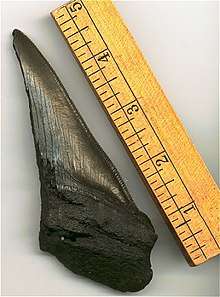Carcharocles chubutensis
Carcharocles chubutensis, meaning "glorious shark of Chubut", from Ancient Greek: κλέϝος (kléwos) “glory/fame” + καρχαρίας (karkharías) “shark”, is an extinct species of prehistoric megatoothed sharks in the genus Carcharocles, that lived during Oligocene, Miocene, and Pliocene epochs, approximately 28 – 5 million years ago.[1] This shark is considered to be a close relative of the famous prehistoric megatoothed shark, C. megalodon.[1] However, as is the case with C. megalodon, the classification of this species is disputed.
| Carcharocles chubutensis | |
|---|---|
 | |
| Partially preserved C. chubutensis broken tooth with a slant height of 129 mm (5.1 in) | |
| Scientific classification | |
| Kingdom: | Animalia |
| Phylum: | Chordata |
| Class: | Chondrichthyes |
| Order: | Lamniformes |
| Family: | †Otodontidae |
| Genus: | †Carcharocles |
| Species: | †C. chubutensis |
| Binomial name | |
| †Carcharocles chubutensis Ameghino, 1901 | |
| Synonyms | |
| |
Taxonomy
As is the case with other known megatoothed sharks, the genus of C. chubutensis remains in dispute.[2] The Swiss naturalist Louis Agassiz first identified this shark as a species of Carcharodon in 1843.[3] In 1906, Ameghino renamed this shark as C. chubutensis.[4] In 1964, shark researcher, L. S. Glikman recognized the transition of Otodus obliquus to C. auriculatus. In 1987, shark researcher, H. Cappetta reorganized the C. auriculatus - C. megalodon lineage and placed all related megatoothed sharks along with this species in the genus Carcharocles. Finally, the complete Otodus obliquus to C. megalodon progression became clear and has since gained the acceptance of many shark researchers.[5]
Within the Carcharocles lineage; C. chubutensis is the succeeding species of C. angustidens and is followed by C. megalodon.[1] In short, C. chubutensis is considered a possible ancestor of C. megalodon.[1][5][6] However, due to its co-existence with C. megalodon during the Miocene and Pliocene epochs, it is regarded as a morpho-species.[1]
Size
Carcharocles chubutensis was larger than C. angustidens.[2] Teeth of C. chubutensis can approach 130 millimetres (5.1 in) in slant height (diagonal length),[4] which according to a size estimation method proposed by Gottfried et al., in 1996, indicate a 12.2 m (40 ft) long specimen.[4]
Paleoecology
Paleontological research suggests that this species may have changed habitat preferences through time, or it may have had enough behavioral flexibility to occupy different environments at different times.[7]
Fossil record
This species is also known from fossil teeth and some fossilized vertebral centra. Shark skeletons are composed of cartilage and not bone, and cartilage rarely gets fossilized. Hence, fossils of C. chubutensis are generally poorly preserved. Although the teeth of C. chubutensis are morphologically similar to teeth of C. megalodon,[8] they are comparatively slender with curved crown, and with presence of lateral heels feebly serrated.[7] Fossils of this species have been found in North America,[7] South America,[7] Africa,[9] and Europe.[10]
See also
- List of prehistoric fish
- Largest prehistoric organisms
References
- Renz, Mark (2002). Megalodon: Hunting the Hunter. PaleoPress. pp. 26–30. ISBN 0-9719477-0-8.
- Gottfried M.D.; Fordyce R.E (2001). "An Associated Specimen of CARCHARODON ANGUSTIDENS (CHONDRICHTHYES, LAMNIDAE) From the LATE OLIGOCENE of NEW ZEALAND, with comments on CARCHARODON Interrelationships". Journal of Vertebrate Paleontology. 21 (4): 730–739. doi:10.1671/0272-4634(2001)021[0730:AASOCA]2.0.CO;2. ISSN 0272-4634.
- Klimley, Peter; Ainley, David (1996). Great White Sharks: The Biology of Carcharodon carcharias. Academic Press. ISBN 0-12-415031-4.
- Andres, Lutz. "Megatooth Fossils Found at the Calvert Cliffs of Maryland". Retrieved 2010-05-10.
- Andres, Lutz (2002). "C. megalodon — Megatooth Shark, Carcharodon versus Carcharocles". Retrieved 2010-05-10.
- Bruner, John (1997). "The "Megatooth" shark, Carcharodon megalodon". Mundo Marino Revista Internacional de Vida Marina.
- Aguilera O.; Augilera E. R. D. (2004). "Giant-toothed White Sharks and Wide-toothed Mako (Lamnidae) from the Venezuela Neogene: Their Role in the Caribbean, Shallow-water Fish Assemblage". Caribbean Journal of Science. 40 (3): 362–368.
- Nyberg K.G; Ciampaglio C.N; Wray G.A (2006). "Tracing the ancestry of the GREAT WHITE SHARK". Journal of Vertebrate Paleontology. 26 (4): 806–814. doi:10.1671/0272-4634(2006)26[806:TTAOTG]2.0.CO;2. ISSN 0272-4634.
- Cook, Todd D.; Alison M. Murray; Elwyn L. Simons; Yousry S. Attia; Prithijit Chatrath (18 February 2010). "A Miocene selachian fauna from Moghra, Egypt". Historical Biology. Egypt. 22 (1–3): 78–87. doi:10.1080/08912960903249329.
- Marsili, Stefano; Giorgio Carnevale; Ermanno Danesea; Giovanni Bianuccia; Walter Landinia (March 2007). "Early Miocene vertebrates from Montagna della Maiella, Italy". Annales de Paléontologie. Italy: Elsevier. 93 (1): 27–66. doi:10.1016/j.annpal.2007.01.001.
External links
- Carcharocles: Extinct Megatoothed shark from ELASMO
- Megatooth Shark Information - Facts, Evolution, Extinction, Fossil Examples from Fossilguy.com